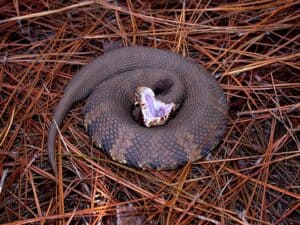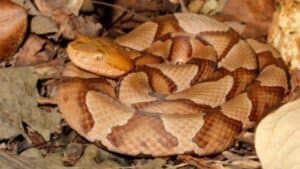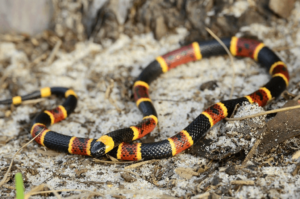Central Texas is known for being a snake hotspot with 113 species and subspecies of snakes calling Texas home. According to Texas Parks and Wildlife, 95% of snake bites occur between April and October. As we move into snake season, it’s important to learn how to identify venomous snakes, how to avoid snakes, what to do if you see a snake, and what to do if you get bit.
Texas Snakes
There are four types of venomous snakes in Texas: rattlesnakes, copperheads, cottonmouths, and coral snakes. Other non-venomous Texas snakes include garden snakes, rat snakes, and whip snakes. Bites from these non-venomous ones won’t kill you but they can cause inflammation or infection in the healing process.
Rattlesnakes have broad triangular heads, cat-like pupils, scales, various patterns/colors, large fangs, and a mouth that opens like a hinge. They may or may not rattle based on age and if they have lost or broken theirs.

Cottonmouths (water moccasins) are semi-aquatic with large triangular heads, dark cat-like eyes, variable color, larger jowls, and larger in size. They’re usually found in or near the water.
 Copperheads have an hourglass pattern in copper and/or tan colors. Young snakes will have bright yellow tails and triangular heads.
Copperheads have an hourglass pattern in copper and/or tan colors. Young snakes will have bright yellow tails and triangular heads.

Coral Snakes have brightly-colored, patterned bodies with red, yellow, and black bands that are complete rather than breaking at the belly. They have black noses and short, fixed fangs. Their bites are rare but very toxic.
 How to Prevent Snake Bites
How to Prevent Snake Bites
Snake sightings can be scary and it’s often hard to remember what to do in the moment. Both knowing where snakes like to hide and what to do when you see a snake can prevent painful and dangerous bites.
Snakes like to hang out in tall grass, under fallen trees, on the underside of rocks, creek beds, underbrush, animal burrows, cool dark places, and in the water. People often forget that beautiful fields of wildflowers are often home to snakes. Try to avoid places like these where snakes are likely to be hiding. And if you do find yourself in one of these places, stay vigilant!
If you see a snake, stop moving. Humans are not seen as prey to snakes, so unless you provoke them, they shouldn’t harm you. While staying still and calm, allow the snake to withdraw. Then, you can slowly take two large steps backwards out of danger.
What to Do if You Are Bitten by a Snake
If you are bitten by a snake, DO:
- Remain calm and remember what time you were bitten.
- Remove tight jewelry and clothing in case swelling occurs.
- Seek immediate medical care–anti-venom can be given anytime is most effective in the first 4-6 hours.
If you are bitten by a snake, DO NOT:
- Do not apply heat, ice, or tourniquet (nothing that restricts blood flow).
- Do not try to suck out the venom.
- Do not capture the snake to bring to the ER–photos are more helpful and safer!
Seeking Medical Care After a Snake Bite
Anyone who receives a snake bit should seek medical attention. Even non-venomous snake bites should be examined by a medical professional to manage pain or swelling. If the snake is venomous or if you are unsure, call 911 or try to find an emergency room with antivenom on hand. You shouldn’t drive yourself to an ER since snake bites can cause dizziness and fainting. Instead have a friend or family member drive you. If you’re somewhere with bad cell service, it is a good idea to have prepared a written list of ERs with snake antivenoms. Our Ally Medical Bastrop location carries antivenom for rattlesnake, water moccasin, and copperhead bites, and our Bastrop team members are experts at treating venomous snake bites.
For more information watch our segment on KXAN about snake bite facts and myths here.
Resources
https://www.cdc.gov/niosh/topics/snakes/symptoms.html
https://tpwd.texas.gov/education/resources/texas-junior-naturalists/snakes-alive/snake-bit



